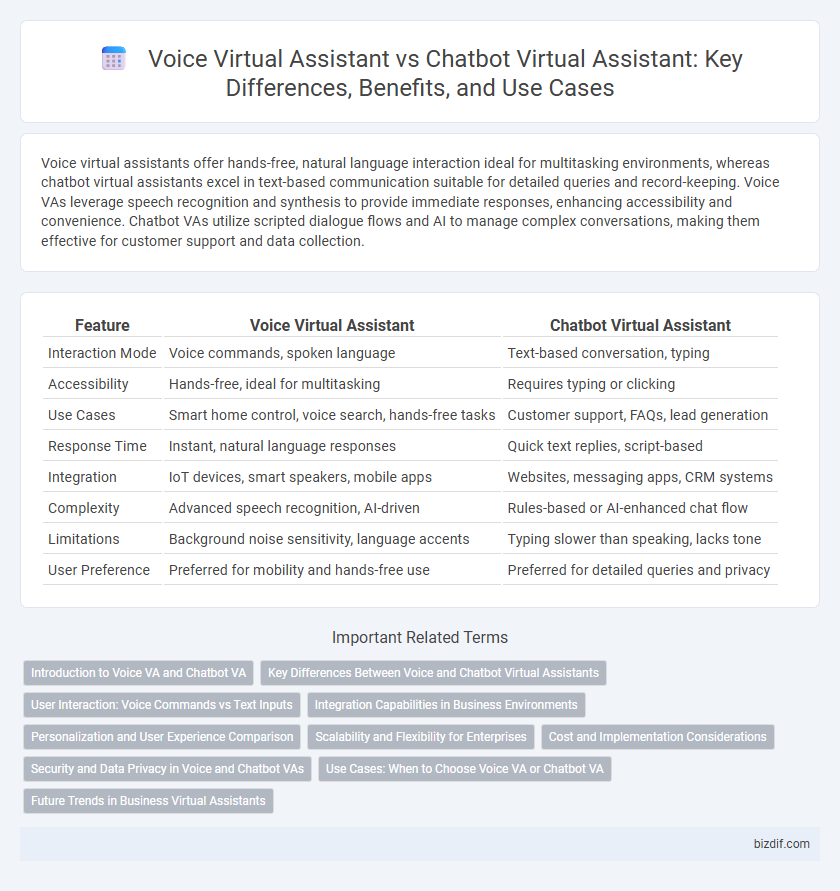Voice virtual assistants offer hands-free, natural language interaction ideal for multitasking environments, whereas chatbot virtual assistants excel in text-based communication suitable for detailed queries and record-keeping. Voice VAs leverage speech recognition and synthesis to provide immediate responses, enhancing accessibility and convenience. Chatbot VAs utilize scripted dialogue flows and AI to manage complex conversations, making them effective for customer support and data collection.
Table of Comparison
| Feature | Voice Virtual Assistant | Chatbot Virtual Assistant |
|---|---|---|
| Interaction Mode | Voice commands, spoken language | Text-based conversation, typing |
| Accessibility | Hands-free, ideal for multitasking | Requires typing or clicking |
| Use Cases | Smart home control, voice search, hands-free tasks | Customer support, FAQs, lead generation |
| Response Time | Instant, natural language responses | Quick text replies, script-based |
| Integration | IoT devices, smart speakers, mobile apps | Websites, messaging apps, CRM systems |
| Complexity | Advanced speech recognition, AI-driven | Rules-based or AI-enhanced chat flow |
| Limitations | Background noise sensitivity, language accents | Typing slower than speaking, lacks tone |
| User Preference | Preferred for mobility and hands-free use | Preferred for detailed queries and privacy |
Introduction to Voice VA and Chatbot VA
Voice virtual assistants utilize speech recognition and natural language processing to enable hands-free interaction, allowing users to perform tasks through spoken commands. Chatbot virtual assistants operate via text-based interfaces, engaging users in written conversations to provide support, answer queries, or facilitate services. Both technologies enhance user experience by delivering personalized, real-time assistance across multiple platforms.
Key Differences Between Voice and Chatbot Virtual Assistants
Voice virtual assistants rely on speech recognition technology to interpret spoken commands, enabling hands-free and intuitive user interactions. Chatbot virtual assistants utilize text-based communication through messaging platforms, offering detailed and structured responses best suited for complex queries. The key differences lie in input modes, user experience, and adaptability to various contexts, with voice assistants excelling in real-time, conversational exchanges and chatbots providing precise, text-driven support.
User Interaction: Voice Commands vs Text Inputs
Voice virtual assistants excel in handling voice commands, allowing users to interact hands-free through natural speech recognition, enhancing accessibility and convenience in various environments. Chatbot virtual assistants primarily rely on text inputs, providing precise responses in written form that are ideal for environments requiring quiet or discreet communication. Both interaction modes optimize user experience by leveraging context-specific input methods tailored to user preferences and situational needs.
Integration Capabilities in Business Environments
Voice virtual assistants offer seamless integration with smart devices and customer service platforms, enabling hands-free interaction and real-time voice command processing. Chatbot virtual assistants excel in multi-platform deployment across websites, social media, and messaging apps, providing text-based automated support with customizable workflows and API connectivity. Businesses benefit from combining both voice and chatbot VAs to enhance customer engagement and streamline operations through complementary integration capabilities.
Personalization and User Experience Comparison
Voice virtual assistants utilize speech recognition and natural language processing to offer personalized, hands-free interactions that adapt to individual user preferences and contexts. Chatbot virtual assistants typically provide text-based communication on multiple platforms, enabling quick and tailored responses through scripted or AI-driven conversation flows. Personalized user experience in voice VAs often leads to higher engagement due to intuitive voice commands, whereas chatbots excel in accessibility and detailed information delivery across various devices.
Scalability and Flexibility for Enterprises
Voice virtual assistants offer scalable solutions by handling numerous simultaneous voice interactions, enhancing operational efficiency in enterprises. Chatbot virtual assistants provide greater flexibility with customizable text-based workflows and easy integration across diverse digital platforms. Enterprises benefit from leveraging voice VA for real-time voice engagement and chatbot VA for adaptable customer experience management.
Cost and Implementation Considerations
Voice virtual assistants typically incur higher initial costs due to advanced speech recognition and natural language processing technologies, whereas chatbot VAs benefit from lower development expenses focused on text-based interactions. Implementation time for voice VAs is often longer as it requires integration with voice platforms and compliance with diverse acoustic environments, while chatbots can be rapidly deployed on websites, messaging apps, or social media. Operational costs also vary, with voice VAs demanding continuous improvements for voice accuracy and latency, contrasting with chatbot maintenance centered on text comprehension and response enhancements.
Security and Data Privacy in Voice and Chatbot VAs
Voice virtual assistants (VAs) rely on voice recognition technology, which can be vulnerable to unauthorized access if voiceprints are improperly secured, raising concerns about biometric data privacy. Chatbot VAs typically process text data, allowing for easier implementation of encryption and access controls to protect sensitive user information. Both voice and chatbot VAs require stringent security measures such as end-to-end encryption, secure authentication, and compliance with data protection regulations like GDPR to safeguard user data effectively.
Use Cases: When to Choose Voice VA or Chatbot VA
Voice virtual assistants excel in hands-free environments like driving, smart home control, and on-the-go information retrieval, providing quick, natural language responses. Chatbot virtual assistants perform best in text-based customer support, detailed FAQs, and complex troubleshooting where users prefer written instructions or need to review interaction history. Organizations should select Voice VA for real-time, conversational interactions and Chatbot VA for asynchronous, scalable text interactions requiring detailed context.
Future Trends in Business Virtual Assistants
Voice virtual assistants are rapidly evolving with advancements in natural language processing and AI, enabling more intuitive and hands-free interactions compared to chatbot virtual assistants. Future business virtual assistants will integrate multimodal capabilities, combining voice, chat, and visual interfaces to enhance user engagement and operational efficiency. Predictive analytics and contextual understanding will drive personalized experiences, making voice VAs indispensable for customer service and workflow automation in enterprise environments.
Voice VA vs Chatbot VA Infographic

 bizdif.com
bizdif.com